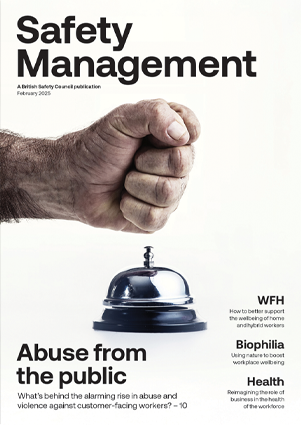Cognitive neuroscientist Javid Farahani will be speaking at the SHW Live exhibition in Farnborough in September on how simple technology can assess the cognitive health and fitness of employees – and provide them and their employers with simple ideas for improving their performance and resilience to stress.
Features
Neuroscience: how it can support employee health, safety and wellbeing
While many of us have dreamed of being professional sports stars it’s difficult to correlate what we do in our daily work with the heroics we see on TV or in the news. However, according to Javid Farahani, a specialist in applied cognitive neuroscience and the CEO of CogMap, we have more in common with our sporting heroes than we perhaps realise.
“At CogMap we are a group of cognitive neuroscientists working on understanding and improving human performance,” he says. “Our journey began by measuring and mapping the cognitive skills of elite athletes, taking the first step towards understanding the upper levels of human performance.
“Building on what we learned from elite athletes we are now taking the next step to improve the performance and wellbeing of individuals and teams in the working environment.”
 Javid Farahani: "Building on what we learned from elite athletes we are now taking the next step to improve the performance and wellbeing of people at work."
Javid Farahani: "Building on what we learned from elite athletes we are now taking the next step to improve the performance and wellbeing of people at work."
After reviewing the data and insights gathered from its recent projects on cognitive fitness, cognitive fatigue and cognitive resilience Javid believes that “the focus on workplace safety demands a game-changing approach. With mounting concerns around fatigue management, drugs consumption, mental health risks, and even suicide, it is imperative that we make a profound impact on the minds of decision-makers and inspire transformation through the power of knowledge.”
In his presentation (at 11.45am on Thursday 28 September in the SHW Live Wellbeing Hub), Javid will argue that by prioritising the measurement of cognitive fitness over workplace stress alone, it is possible to tap into a realm of immense advantages. Notably, measuring workplace stress only and not brain function means that only a fraction of the low-cost or no-cost changes that can be promptly implemented and tested are revealed, as will be explained further on.
Cognitive fitness refers to the overall health and ability of the brain to function optimally, including attention, processing speed and decision-making. It encompasses the cognitive abilities that enable an individual to perform daily tasks effectively.
“An example of this is the work we have done with an international healthcare business,” explains Javid. “We measured the cognitive fitness of the team across the day using games that test visual information processing.
“There was a ‘warm-up’ section in the morning and a ‘cool down’ section in the afternoon and by measuring the gap in performance between warm-up and cool down we get a score on their performance, allowing us to make some immediate and no-cost interventions. One of them was a change of temperature in the workplace – if you reduce the temperature, you are making the environment more suitable for the brain to function – and you might make some energy savings too.”
Improved performance can be attained in ways as simple as having a 15-minute nap, or getting a coffee or some water. Photograph: iStock
Javid adds: “Reducing noise and air pollution are two other easy ways to get results, such as reduced absenteeism, quickly. Lighting also falls into this category, and this leads to an improvement in employees’ wellbeing scores (when they are captured and assessed). We did a hospital project and by introducing smart lighting the team were more alert and this reduced safety errors and reduced the turnover of employees.”
Javid adds: “We call these ‘Cog Hacks’ and the idea is each employee does a very rapid assessment by playing a game, which from start to finish takes 60 seconds. This will give workers an idea of how well they are performing and will also act as an indicator for their mood and energy level.
“When workers are tested the next day, if they are not at the baseline level of performance when compared to their usual scores, then we can let them know that something has changed
and simply by becoming aware of this an individual will begin to think about their alertness.
“At this point we can introduce a simple idea from elite sports, military or aviation which explains what someone in one of these fields does when they are feeling tired, and suggest the employee does the same to get some benefit. It can be as simple as having a 15-minute nap, or getting a coffee or some water. People can learn from these elite performers and bring ideas into their own workplace, which most find exciting and effective.”
Guiding principle
A guiding principle of Javid’s methodology is “outcome equals potential, minus process losses” and, drawing on insights from other industries, such as sports, where fatigue management plays a pivotal role in predicting injuries and enhancing performance, he believes it’s possible to unlock a deep understanding of effective health and safety management.
“I believe,” says Javid, “that every outcome depends on increasing the capacity and the potential of an individual by training, or providing them with new tools, or by empowering them in different ways. However, these are all impacted by different timescales and costs.
“For example, if a worker is offered training, they have to find the time to attend the training and may be unable to complete their work at that specific time. But an alternative approach is to focus on what is stopping the individual from performing at their best or is reducing their current potential and to try to improve that.
“Some of the factors that could be affecting employee performance are fatigue, insufficient or poor-quality sleep and the consumption of sugar.
“For example, benefits can be gained from eating foods that slowly release energy rather than chocolate bars. Improving ‘process losses’ is easier to achieve than increasing capacity and potential or, more simply; it is easier to take away the barriers that are preventing people being good at their job than training them to get better at it.”
 "Some of the factors that could be affecting employee performance are fatigue, insufficient or poor-quality sleep and the consumption of sugar." Photograph: iStock
"Some of the factors that could be affecting employee performance are fatigue, insufficient or poor-quality sleep and the consumption of sugar." Photograph: iStock
Schedules, Shifts and Chronotypes
Javid’s presentation will address three key areas. The first of these is ‘Schedules, Shifts and Chronotypes’. ‘Chronotypes’ is the theory that everyone is at their peak at some point during the day. Some people are night owls, and some are early birds and therefore to get optimum performance it’s important that the individual aligns the time they are feeling their best with the period they undertake their most important tasks. However, this can sometimes be at odds with the majority of working hours and demands, where we arrive at the workplace at 9am and depart at 5pm.
“Two things about this are important,” says Javid, “the first is if you know that you are a ‘morning’ or ‘afternoon’ person we’ll help you to identify the right time to do the difficult jobs. The second thing is knowing this in the context of a team. If you are an employer in charge of a night shift, then you ideally want a mix of chronotypes so that people can cover for each other. If the employer knows the chronotypes of the available workers this will help them to achieve a balanced team.
“Also, there’s the fact that people respond to fatigue in different ways – for instance, some people will need three days to recover from a night shift and some may only need one day. Again, knowing this can be a huge benefit when it comes to wellbeing, averting risk and preventing accidents.”
Javid believes that optimising employee performance hinges upon aligning people’s chronotypes and shifts, therefore enabling workers to experience complete mental and physical recovery after work.
Furthermore, an inappropriate mix of chronotypes within teams creates vulnerabilities that compromise overall performance.
A recent example was seen in an NHS project where a team of five running a night shift were all early birds and there was a real danger of performance becoming compromised due to sleepiness in the hours just before and after midnight. During his presentation Javid will outline successful examples from businesses that have mastered these elements, resulting in improved productivity and wellbeing.
The impact of fatigue and stress
The second key area is ‘Fatigue and Stress Sensitivity’. Scientific studies across diverse fields, including sports and construction, demonstrate that humans respond differently to various forms of pressure, encompassing mental and physical fatigue.
Remarkably, a select group excels when faced with such challenges. Recognising and comprehending this exceptional group holds immense value for an employer. For example, it can help a business to refine its hiring practices so it can more easily spot those who can cope better with pressure (or may struggle with it) and it can help an employer to draw up targeted assessment procedures in order to accurately identify candidates who will be able to succeed in the role.
Javid says: “We must acknowledge employees’ diverse reactions to fatigue and stress as the current system falls short in objectively gauging these differences, hindering our ability to forecast and rectify errors.
“By embracing a comprehensive understanding of these variations, we unlock the potential for enhanced decision-making and optimised outcomes.
“If a cognitive fitness assessment process is used then the organisation accumulates data on the types of candidates that are successful in that role and can make more informed decisions.”
The final key element that will be covered in Javid’s presentation is ‘Environment Design’. Regrettably, many work environments are inadequately designed to meet the necessary requirements for optimal and secure performance, particularly during night shift operations.
Factors like lighting conditions, noise, temperature levels, available food choices and individuals’ physical activity levels are often overlooked, yet they have a direct impact on cognitive capabilities.
Numerous studies demonstrate the feasibility of assessing the brain’s response to environmental factors in both short and long-term scenarios. By taking a comprehensive approach that measures the influence of environmental factors on cognitive performance, decision-makers can understand more about their staff, surpassing the mere consideration of stress factors which are tracked through staff surveys and complaints or observed through behaviour.
Tracking, tuning and transforming Javid’s presentation will then reveal how these various factors can be addressed at work and among employees. “I believe the most valuable asset of any company in any sector is human beings,” he says. “There is a need to track the cognitive fitness of people, to tune it when necessary and as a result to progress them to the next level which is when there is a long-term productive relationship between the employee, their job and their employer.
“Having measurement tools in place removes the barriers to happiness and contentment at work that are created by invisible enemies such as fatigue and stress. If they are measured they can be managed for everyone’s benefit.”
Remarkably this ‘tracking, tuning and transforming’ is all achieved through employees regularly playing a series of visual information processing games which they can access via their desktop or via apps on their phone. These games measure such factors as attention span, decision-making and memory and are bespoke to each industry sector or job function.
In conclusion and looking forward to his presentation Javid summarises what he hopes to communicate.
“By prioritising an all-encompassing evaluation framework, we can create safer work environments that enhance employee wellbeing and optimise overall performance. Proactively addressing cognition regarding workplace health and safety is not only the responsible thing to do but is also strategic, leading to long-term benefits for employees and businesses alike.”
SHW Live South takes place at Farnborough in Hampshire on 27–28 September and is free to attend. Register at:
safetyhealthwellbeing.live
For more information on
CogMap visit:
cogmap.ai
Javid Farahani is CEO of CogMap, he holds a PhD in applied cognitive neuroscience.
FEATURES

Adaptability, ergonomics and wellbeing: building blocks for the workplace in 2025
By Guy Osmond, Osmond Ergonomics and Alex Reffell, Osmond Inclusive Wellbeing Services on 04 February 2025
Employee expectations around the nature and organisation of office, home and hybrid working have changed significantly in recent years, making it more important than ever for employers to rethink and update their approaches to flexible working, ergonomics and workplace design, to better support employee wellbeing, motivation and job satisfaction.

Supporting wellbeing across the flexible extended workplace: why we need a different approach
By Andy Lake, Flexibility.co.uk on 04 February 2025
Flexible working has been shown to offer numerous benefits, from improved employee wellbeing to greater productivity. But the rapidly changing nature of work in a digital age means employers need to take a strategic, joined-up approach when implementing flexible working practices, if they are to fully realise the benefits.

Supporting wellbeing when working from home: some key tips
By Nigel Oseland, Workplace Unlimited on 31 January 2025
Home and hybrid working are now firmly established as regular working patterns for significant numbers of people, so it’s a good time for employers to revisit their arrangements for supporting the wellbeing of home workers – from ensuring good ergonomic workstation set-ups to encouraging regular rest breaks.



